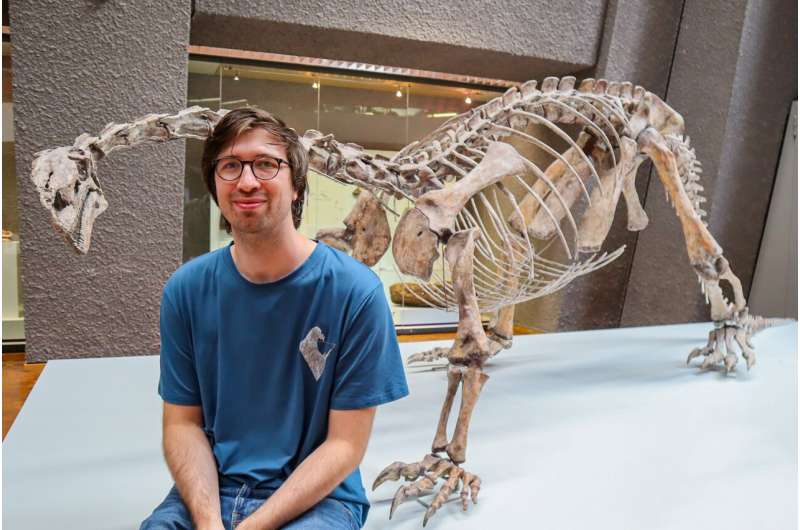This article has been reviewed according to Science X's editorial process and policies. Editors have highlighted the following attributes while ensuring the content's credibility:
fact-checked
peer-reviewed publication
trusted source
proofread
New insights into one of Europe's oldest dinosaurs

A comprehensive new description of Plateosaurus trossingensis provides valuable information on the evolution, lifestyle and family tree of early dinosaurs. During this analysis, bone injuries were discovered, which paleontologists investigated in more detail.
Thanks to numerous finds in central Europe, the herbivore Plateosaurus trossingensis is crucial for understanding and researching early dinosaurs. The first complete skeleton of this species from Trossingen in Baden-Württemberg was discovered in 1912 by Eberhard Fraas and was the basis for the first detailed description of the species in 1926.
Joep Schaeffer, paleontologist at the State Museum of Natural History Stuttgart, has re-examined this skeleton of Plateosaurus trossingensis and provided important details on the characteristics of this iconic dinosaur species, its biology and the relationships with other early dinosaurs.
This first detailed re-examination of the holotype of Plateosaurus trossingensis after almost 100 years, has been published in the Journal of Systematic Palaeontology and forms an important basis for future dinosaur research.
When analyzing multiple skeletons from different collections of Plateosaurus trossingensis, bone pathologies on the tail attracted the paleontologist's particular attention. Together with an international team of researchers, Schaeffer examined these injuries in more detail in order to investigate the possible causes. The results of that study were recently published in the journal PLOS ONE.
One of the largest dinosaurs from the Late Triassic
Plateosaurus lived around 210 million years ago in the Late Triassic epoch. This early dinosaur could grow up to 10 meters long and weigh up to 4 metric tons. One of the most important sites where Plateosaurus skeletons have been found is Trossingen in Baden-Württemberg. Most of the fossils discovered there are in the collections of the State Museum of Natural History Stuttgart, as is the holotype of Plateosaurus trossingensis. In total, there are already more than 250 finds of plateosaurids individuals from Germany, Switzerland and France.
Basis for future dinosaur research
The last comprehensive description of the holotype of Plateosaurus trossingensis from 1926 was made by the paleontologist Friedrich von Huene. Since then, there have been discussions about whether Plateosaurus trossingensis is the only species of the genus.
"On the basis of new finds and research results from recent decades, I was able to take new aspects into account in my analysis and provide important details on the anatomy of the skull, and the rest of the skeleton.
"I also reviewed and updated the position of Plateosaurus trossingensis in the phylogenetic tree, showing the relationships of this early dinosaur with others. The new description of Plateosaurus trossingensis is an important basis for future questions in early dinosaur research and for the evaluation of other fossil finds," says Schaeffer.
Dinosaur researchers investigate bone pathologies
An injury to the dinosaur's tail bones caught the attention of the scientist and other paleontologists. Three of the hemal arches appeared to have been injured in the holotype of Plateosaurus when the individual was younger, prompting a research team of paleontologists and a veterinarian to analyze other skeletons. Almost 15% of the Plateosaurus fossils examined showed these injuries, which did not lead to the death of the animals, but left significant damage.
"We already know a lot about Plateosaurus, for example, how heavy they became, what they ate, or even when they became sexually mature. A great deal is also known about their habitat thanks to the analysis of the rocks containing the fossils. Every piece of the puzzle helps us to understand more about the biology and ecology of the animals. It is therefore particularly exciting for us to identify the injuries and find out the cause," says Schaeffer.
The scientists are considering various scenarios for the origin of the pathologies. One possibility is that the animals could have gotten stuck in the mud; the injuries would have occurred when they were struggling to get out of the mud with their tails. A second option is that the dinosaurs hit their tails during social interactions. Attacks by predators are another hypothesis.
Were predators the cause of Plateosaurus' injuries?
"One predator that could have caused the injuries is the carnivorous dinosaur Liliensternus, but considering its size, it could only have injured young Plateosaurus individuals. Other potential predators were phytosaurs and crocodile ancestors. These crocodile relatives typically attacked their victims from below and the rear, which would fit the injuries on the bones, although no tooth marks were left.
"So far, however, no fossils of these crocodile relatives have been discovered in Trossingen, but some specimens are known from contemporary localities. To clarify this question, we must therefore wait for further finds," says Dr. Eudald Mujal, a paleontologist specializing in fossil preservation and paleoecology at the State Museum of Natural History in Stuttgart.
More information: Joep Schaeffer, Osteological redescription of the holotype of Plateosaurus trossingensis (Dinosauria: Sauropodomorpha) from the Upper Triassic of SW Germany and its phylogenetic implications, Journal of Systematic Palaeontology (2024). DOI: 10.1080/14772019.2024.2335387
Joep Schaeffer et al, Paleobiological implications of chevron pathology in the sauropodomorph Plateosaurus trossingensis from the Upper Triassic of SW Germany, PLOS ONE (2024). DOI: 10.1371/journal.pone.0306819
Journal information: Journal of Systematic Palaeontology , PLoS ONE
Provided by State Museum of Natural History Stuttgart





















